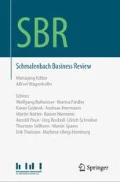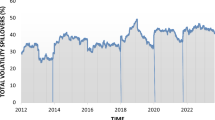Abstract
This paper investigates determinants of banks’ structural exposure to interest rate risk in their banking book. Using bank-level data for German banks, we find evidence that a bank’s exposure to interest rate risk depends on its presumed optimization horizon. The longer the presumed optimization horizon is, the more the bank is exposed to interest rate risk in its banking book. Moreover, there is evidence that banks hedge their earnings risk resulting from falling interest levels with exposure to interest rate risk. The more a bank is exposed to the risk of a decline in the interest rate level, the higher its exposure to interest rate risk.


Similar content being viewed by others
Notes
Note that whenever we refer to banks’ interest rate risk exposure in this paper, we have their interest rate risk in the banking book in mind, i.e. the interest rate risk resulting from the banks’ traditional business and not from their trading activities.
See Vuillemey (2016) for an overview of the interest rate risk bearing in banking from a macroeconomic point of view.
The concept of the so-called “pull-to-par” effect (in the context of bonds) is closely related to the reasoning above.
In Appendix 1, we show how a bank optimizes its exposure to interest rate risk if the optimization horizon is continuous, and not discrete with only two possible values as in the case above. However, as we have only dummy variables in the empirical study to characterize the optimization horizon, we concentrate on the model above.
This approximation corresponds to the first-order Taylor approximation of the term \(1/a\) at \(a=1\).
The hedging component in the case of investors maximizing their wealth \(t=2\) is zero.
In Table 2 in Sect. 4.2, it is shown that the share of the serial variation of the variable \({IRR}\), the exposure to interest rate risk, is much higher than the share of the variable \(\theta\), namely 24% (= 100% – 76%) vs. 6% (= 100% – 94%). This finding supports the assumption that the exposure to interest rate risk (\({IRR}\)) is much easier to alter than the long-run pass-through \(\theta\) of the bank’s assets and liabilities.
Busch and Memmel (2017) find a long-run effect on the net interest margin for the small and medium size banks in Germany of 8 bps per 100-bp shift in the term structure, while the effect for the more wholesale oriented large banks amounts to 3 bps.
In addition, English (2002) argues that, in theory, the change in economic (or present) value should be equal to the present value of the changes in the stream of future net interest incomes.
Note the resemblance to the theoretical concept of the variance decomposition (see, for instance, Greene (2012)): \(var(x)={var}(E(x|y))+E({var}(x|y))\) where \(y\) contains the bank-specific information.
Note that the duration is defined as a positive number.
Memmel and Schertler (2013) find for the German banks not using derivatives that, for the median bank, 92.1% of the assets and 89.8% of the liabilities (including some parts of equity) are interest bearing.
References
Acharya, V.V., T. Eisert, C. Eufinger, and C. Hirsch. 2016. Whatever it takes: the real effects of unconventional monetary policy. New York: mimeo.
Albertazzi, U., and L. Gambacorta. 2009. Bank profitability and the business cycle. Journal of Financial Stability 5(4):393–409.
Alessandri, P., and B. Nelson. 2015. Simple banking: profitability and the yield curve. Journal of Money, Credit and Banking 47(1):143–175.
Allen, F., and D. Gale. 1997. Financial markets, intermediaries and intertemporal smoothing. Journal of Political Economy 105:523–546.
Angbazo, L. 1997. Commercial bank net interest margins, default risk, interest rate risk and off balance sheet activities. Journal of Banking and Finance 21:55–87.
Basel Committee on Banking Supervision. 2004. Principles for the management and supervision of interest rate risk. Basel: Bank for International Settlements.
Bolt, W., L. de Haan, M. Hoeberichts, M. Oordt, and J. Swank. 2012. Bank profitability during recessions. Journal of Banking and Finance 36:2552–2564.
Busch, R., and C. Memmel. 2016. Quantifying the components of the banks’ net interest margin. Financial Markets and Portfolio Management 30(4):371–396.
Busch, R., and C. Memmel. 2017. Banks’ net interest margin and the level of interest rates. Credit and Capital Markets 50(3):363–392.
Claessens, S., N. Coleman, and M. Donnelly. 2017. “Low-for-long” interest rates and banks’ interest margins and profitability: cross-country evidence. Journal of Finacial Intermediation https://doi.org/10.1016/j.jfi.2017.05.004.
Dell’Ariccia, G., L. Laeven, and R. Marquez. 2014. Real interest rates, leverage, and bank risk-taking. Journal of Economic Theory 149:65–99.
Deutsche Bundesbank. 2015. Financial stability review 2015.
Diamond, D.W., and P. Dybvig. 1983. Bank runs, deposit insurance and liquidity. Journal of Political Economy 91:401–419.
English, W.B. 2002. Interest rate risk in the bank net interest margins. bIS Quarterly Review. December 2002.
Freund, R.J. 1956. The introduction of risk into a programming model. Econometrica 24:253–263.
Froot, K.A., and J.C. Stein. 1998. Risk management, capital budgeting, and capital structure policy for financial institutions: an integrated approach. Journal of Financial Economics 47:55–82.
De Graeve, F., O. De Jonghe, and R.V. Vennet. 2007. Competition, transmission and bank pricing policies: evidence from Belgian loan and deposit markets. Journal of Banking and Finance 31:259–278.
Greene, W.H. 2012. Econometric analysis, 7th edn., New Jersey: Prentice Hall.
Heider, F., F. Saidi, and G. Schepens. 2017. Life below zero: bank lending under negative policy rates. SSRN: https://ssrn.com/abstract=2788204.
Hellwig, M.F. 1994. Liquidity provision, banking, and the allocation of interest rate risk. European Economic Review 38:1363–1389.
Kleimeier, S., and H. Sander. 2006. Expected versus unexpected monetary policy impulses and interest rate pass-through in euro-zone retail banking markets. Journal of Banking and Finance 30:1839–1870.
McShane, R.W., and I.G. Sharpe. 1985. A time series/cross section analysis of the determinants of Australian trading bank loan/deposit interest margins: 1962-1981. Journal of Banking and Finance 9:115–136.
Memmel, C. 2011. Banks’ exposure to interest rate risk, their earnings from term transformation, and the dynamics of the term structure. Journal of Banking and Finance 35:282–289.
Memmel, C., and A. Schertler. 2013. Banks’ management of the net interest margin: new measures. Financial Markets and Portfolio Management 27(3):275–297.
Schrand, C., and H. Unal. 1998. Hedging and coordinated risk management: evidence from thrift conversions. The Journal of Finance 53(3):979–1013.
Vuillemey, G. 2016. Interest rate risk in banking: a survey. Paris: HEC.
Acknowledgment
The author would like to thank Jérémie Bertrand, Ramona Busch, Yalin Gündüz, Tyler Jensen, Kamil Pliszka, Peter Raupach, Edgar Vogel, Benjamin Weigert, two anonymous referees as well as the participants of the Bundesbank’s research seminar (Frankfurt, 2016), the French Finance Association’s International Conference (Valence, 2017) and the 5th Paris Financial Management Conference (Paris, 2017) for their helpful comments. The views expressed in this paper are those of the author and do not necessarily reflect the opinions of the Deutsche Bundesbank.
Author information
Authors and Affiliations
Corresponding author
Appendix
Appendix
1.1 Appendix 1: Optimal Interest Rate Risk Exposure
Let there be the following relationship between the initial wealth \(W_{0}\) and the wealth in time \(t,W_{t}\):
where \(R\) is the relevant (annualized) interest rate.
Using the first-order Taylor approximation at \(t=0\), we obtain
We assume that there is an overnight parallel shift of the term structure at \(t=0\). This assumed shock is permanent and no further interest rate shocks will take place. Therefore, the initial wealth \(W_{0}\) is exposed to interest rate risk. If the interest rate changes, the present value of the asset changes as well where its modified duration \(D\) gives the sensitivity (\(\bar{R}\) and \(\bar{W}\) are the expectations of \(R\) and \(W\), respectively):Footnote 11
Combining (16) and (17) and neglecting terms of second-order importance, we obtain
We assume that the relevant interest rate risk \(R\) is composed of the interest rate level \(r\) and a term premium that is proportional to the duration, i.e.
where \(c\) is the term premium per year of duration \(D\); in case of a normal term structure, it is positive.
If we assume, in addition, that the interest rate level \(r\) is normally distributed with \(E(r)=\bar{r}\) and \({var}(r)=\sigma_{r}^{2}\), then the wealth in \(t\), \(W_{t}\), is normally distributed as well (see Eq. (18)) and we can, assuming constant absolute risk aversion, state the preferences as follows (see Sect. 3.1), where \(t=T_{i}\) is the exogenous optimization horizon for bank \(i\):
Accordingly, the optimal modified duration \(D_{i}^{*}\) for bank \(i\) is
If the term structure is normal (and \(c\) is therefore positive), the optimal duration for bank \(i\) is greater than its optimization horizon \(T_{i}\).
1.2 Appendix 2: Hedging
We approximate bank \(i\)’s balance sheet as follows. On the asset side, there are two types of assets, namely loans (share: \(\theta_{A,i}\)) and cash (share: \(1-\theta_{A,i}\)). The loans are granted on a revolving basis, are free of credit risk, have an original maturity of \(M_{A,i}\) (which corresponds to the fixed interest period) and their coupons correspond to the prevailing interest rate at the time the loans were issued. Assume that, at the beginning of the year under consideration, there is a parallel shift of the entire term structure by \(\triangle R\). The change in the bank’s net interest margin \(\triangle {NIM}_{i}\) of this year is
where \(\varepsilon_{i}\) is some bank-specific noise and \(\varphi_{A,i}\) is the fraction of the bank’s loans that have become due in the year after the shock, weighted by the period of time in which they mature, i.e. within the year (see Busch and Memmel (2017)):
The modified duration of this bank’s loan portfolio is approximately
An example is given to clarify the topic. Assume that bank \(i\) hands out loans with a maturity (and a fixed interest maturity) of \(M_{A,i}=8\) years. According to Eqs. (23) and (24), the weighted new business in the first year is \(\varphi_{A,i}=6.25\%\) and the modified duration of this portfolio is \(D_{A,i}=4\).
The variables \(\theta_{L,i}\), \(\varphi_{L,i}\) and \(M_{L,i}\) are the corresponding variables on the bank’s liability side.
Rearranging Eq. (22) gives
where \(\theta_{i}:=\theta_{A,i}-\theta_{L,i}\) is bank \(i\)’s (net) long-term pass-through.
Combining Eqs. (24) and (23) and incorporating the result into Eq. (25), we obtain
With \(\beta=\varphi{}_{L,i}> 0\) and \(\gamma=12.5\cdot E_{i}/(A{}_{i}\cdot D_{A,i}\cdot D_{L,i})> 0\), where \(E_{i}:=A_{i}-L_{i}\) denotes the bank \(i\)’s equity, Eq. (26) turns into Eq. (11). To obtain the expression for \(\gamma\), two additional assumptions need to hold. First, we assume that bank \(i\)’s interest bearing assets \(\theta_{A,i}\cdot A_{i}\) correspond to its interest bearing liabilities \(\theta_{L,i}\cdot L_{i}\),Footnote 12 so that the duration \(D_{i}\) of the bank’s equity \(E_{i}\) can be written as
Second, we assume that of the two scenarios for the Basel interest rate coefficient, the rise in the interest level is the relevant one meaning that \({IRR}_{i}=D_{i}\cdot 0.02\).
Rights and permissions
About this article
Cite this article
Memmel, C. Why Do Banks Bear Interest Rate Risk?. Schmalenbach Bus Rev 70, 231–253 (2018). https://doi.org/10.1007/s41464-018-0051-5
Received:
Accepted:
Published:
Issue Date:
DOI: https://doi.org/10.1007/s41464-018-0051-5




